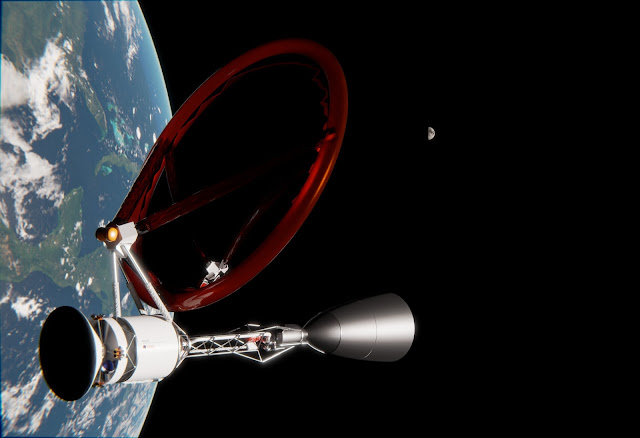 |
Laser-thermal propelled spacecraft in Earth orbit awaiting its departure. Credit: Creative Commons Attribution 4.0 International License |
Is it possible to launch a spaceship to Mars using a laser? That's the name of a mission proposed by a group from McGill University in response to a NASA request. The laser, a 10-meter-wide array on Earth, would heat hydrogen plasma in a chamber behind the spacecraft, producing thrust from hydrogen gas and allowing the spacecraft to reach Mars in 45 days. It would then aerobrake in Mars' atmosphere, transporting supplies to human colonists or, possibly one day, even humans.
NASA issued a challenge to engineers in 2018 to construct a mission to Mars that could transport a payload of at least 1,000 kg in less than 45 days, as well as lengthier journeys deep into and out of the solar system. The aim to convey supplies and, perhaps, astronauts to Mars while reducing their exposure to the destructive effects of galactic cosmic rays and solar storms drove the short delivery time. With its chemical-based rockets, Elon Musk's SpaceX estimates that a human voyage to Mars will take six months.
McGill's concept, called laser-thermal propulsion, relies on an array of infrared lasers based on Earth, 10 meters in diameter, combining many invisible infrared beams, each with a wavelength of about one micron, for a powerful total of 100 megawatts—the electric power required for about 80,000 U.S. households. The payload, orbiting in an elliptical medium Earth orbit, would have a reflector that directs the laser beam coming from Earth into a heating chamber containing a hydrogen plasma. With its core then heated as high as 40,000 degrees Kelvin (72,000 degrees Fahrenheit), hydrogen gas flowing around the core would reach 10,000 K (18,000 degrees Fahrenheit) and be expelled out a nozzle, creating thrust to propel the ship away from Earth over an interval of 58 minutes. (Side thrusters would keep the craft aligned with the laser's beam as Earth rotates.)
When the beaming ceases, the payload accelerates to about 17 kilometres per second in relation to Earth, which is fast enough to get the payload past the moon's orbital distance in less than eight hours. It will still be going at 16 km/s when it reaches the Martian atmosphere in a month and a half; however, once there, placing the payload in a 150-km orbit around Mars is a difficult task for the engineering team to overcome.
Because the payload cannot contain a chemical propellant to launch a rocket to slow itself down, it is difficult—the fuel required would reduce the payload mass to less than 6% of the initial 1,000 kilogrammes. Aerocapture is the sole means to slow the payload at Mars until people on the red planet can build an analogous laser array for the approaching vehicle to use its reflector and plasma chamber to create reverse propulsion.
Even so, the aerocapture, or aerobraking, in Mars' atmosphere could be a risky manoeuvre, with the spacecraft experiencing decelerations of up to 8 g (where g is the acceleration due to gravity at Earth's surface, 9.8 m/s2), which is about the human limit, for only a few minutes as it is captured within a single pass around Mars. The huge heat fluxes on the vessel caused by atmospheric friction would be higher than standard thermal protection system materials, but not those in current development.
Other previously proposed methods of conveyance, such as laser-electric propulsion, in which a laser beam impinges on photovoltaic (PV) cells behind the payload; solar-electric propulsion, in which sunlight on the PV cells creates the propulsive thrust; nuclear-electric propulsion, in which a nuclear reactor creates electricity that produces ions propelled out a thruster; and nuclear-thermal propulsion, in which a nuclear reactor creates electricity that produces ions propelled.
Due to the fact that the power source remains on Earth and the delivered flux can be processed by a low-mass inflatable reflector, the laser-thermal propulsion mission concept presented by Duplay et al. has an extremely low mass-to-power ratio, in the range of 0.001–0.010 kg/kW—"unparalleled," they write, "far below even those cited for advanced nuclear propulsion technologies."
In the 1970s, laser-thermal propulsion was first investigated using 10.6 micron CO2 lasers, which were the most powerful at the time. At one micron, today's fiber-optic lasers can be stacked in massively parallel, phased arrays with a wide, effective diameter, resulting in a focal length of power delivery almost two orders of magnitude greater—50,000 kilometres in Duplay's laser-thermal propulsion idea.
A group lead by scientist Philip Lubin of the University of California in Santa Barbara is developing an architecture for phased-array lasers, according to Duplay. Individual laser amplifiers of roughly 100 watts apiece are used in Lubin's array—each amplifier is a basic loop of fibre optics with an LED light as a pump that can be mass produced cheaply—so the Mars mission envisioned here would require on the order of 1 million individual amplifiers.
The first humans to reach Mars are unlikely to do it using laser-thermal propulsion. "However, if more humans undertake the journey to establish a long-term colony, we will require propulsion systems that bring us there faster—if only to escape radiation threats," says Duplay. He speculates that a laser-thermal expedition to Mars may launch ten years after the first human missions, in 2040.





No comments:
Post a Comment